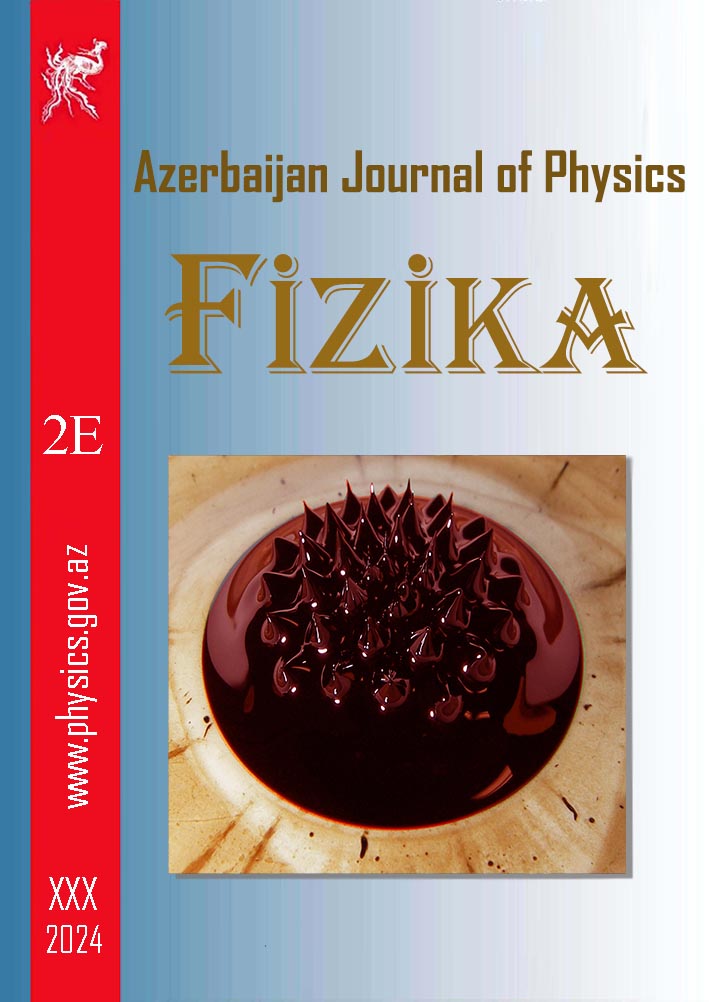ABSTRACT
Ge4As14Se82, Ge4As14S2Se80, Ge7As16S5Se72,
Ge10As20S10Se60, Ge17,5As15S15Se52,5, Ge24As19S20Se37,
Ge25As10S25Se40, Ge26As18S30Se26, Ge33As17S35Se15
chalcogenide glass semiconductor (CGS) compositions are synthesized by the method rotary furnace and amorphousness their powder samples was approved by X-ray diffraction
method. Based on the theory of topological constraints (TCT), it was determined that, since the average coordination number for
Ge10As20S10Se60 satisfies the condition Z = 2.4, the fraction of vibration modes with zero frequency in the chalcogenide glass
is equal f = 0. According to theory this corresponds to "isostatic glass". It is shown that in the compositions (Ge17,5As15S15Se52,5,
Ge24As19S20Se37, Ge25As10S25Se40, Ge26As18S30Se26,
Ge33As17S35Se15) corresponding to the "rigid stress" glass (Z˃2,4, Nco˃3), the size of the average order increases
relatively and varies in the range of L = 25.37 ÷ 33.74 Å.
Keywords: Chalcogenide, glass, amorphous, medium order.
PACS: 81.05.Gc , 61.80.
DOI:-
Received: 23.09.2021
AUTHORS & AFFILIATIONS
1. Institute of Physics of Azerbaijan National Academy of Sciences, 131 H. Javid ave, Baku, AZ-1143, Azerbaijan
2. Azerbaijan State Economic University, 6 Istiglaliyat str., Baku, AZ-1001, Azerbaijan.
E-mail: Rahim-14@mail.ru
|
REFERENCIES
[1] Q. Liu, X. Zhao, F. Gan, et al.. Solid State Commun, , 2005, 134, 513.
[2] J. Keirsse, C. Boussard-Pledel, O. Loreal, et al.. Vib, Spectrosc, 2003, 32, 23.
[3] K. Michel, B. Bureau, C. Pouvreau, et al.. J. Non-Cryst. Solids 326&327, 2003, 434.
[4] M. Frumar, B. Frumarova, T. Wagner. Amorphous and glassy semiconducting chalcogenides, Comprehensive Semiconductor Science and Technology 4. 2011, 206-210.
[5] M. Ghayebloo, M. Tavoosi, M. Rezvani. Compositional Modification of Se-Ge-Sb Chalcogenide Glasses by addition of Arsenic Element, Journal of Infrared Physics and Technology 83, 2017, 62-67.
[6] B. Ye, Sh. Dai, R. Wang, G. Tao, P. Zhang, Xu. Wang, X. Shen. Influence of the selenium content on thermo-mechanical and optical properties of Ge-Ga-Sb-S chalcogenide glasses, Journal of Infrared Physics and Technology 77, 2016, 21-26.
[7] Y. Zhang, J.B. Chou, J. Li, H. Li, Q. Du, A. Yadav, S. Zhou, M.Y. Shalaginov, Z. Fang, H. Zhong, C. Roberts, P. Robinson, B. Bohlin, C. Rios, H. Lin, M. Kang, T. Gu, J. Warner, V. Liberman, K. Richardson, J. Hu. Broadband transparent optical phase change materials for high-performance nonvolatile photonics, Nat Commun, 10, 2019, 4279.
[8] D. Maystre. Diffraction gratings: An amazing phenomenon, Comptes Rendus Physique, 14, 2013, 381-392.
[9] X. Wang, X. Liu, X. Wang. Hydrogel diffraction grating as sensor: A tool for studying volume phase transition of thermo-responsive hydrogel, Sensors and Actuators B: Chemical, 204, 2014, 611-616.
[10] H. Ferhati, F. Djeffal. New high performance ultraviolet (MSM) TiO2/glass photodetector based on diffraction grating for optoelectronic applications, Optic, 127, 2016, 7202-7209.
[11] K. K. Das, M.S. Alam. Fiber-optic micro displacement sensor based on diffraction grating, Microw Opt Techn Let, 32, 2002, 446-449.
[12] K. Tanaka. Amorphous Chalcogenide Semiconductors and Related Materials/ K. Tanaka, K. Shimakawa. New York: Springer Science+Business Media LLC, 2011, 259 p.
[13] R.I. Alekberov, S.I. Mekhtiyeva, A.I. Isayev, M.Fabian. The local structure of As-Se-S chalcogenide glasses studied by neutron diffraction and Raman scattering. J. Non - Crystalline Solids, 2017, 470(15), p.152-159.
[14] S.R. Elliott. Medium-range structural order in covalent amorphous solids. Nature, -1991, 354,-p.445-452.
[15] S.R. Elliott. Second sharp diffraction peak in the structure factor of binary covalent network glasses, Phys. Rev. B: Condens. Matter Mater. Phys., 1995, vol. 51, p. 8599.
[16] L. Tichy and H. Ticha. Mater. Lett. 21, 313, 1994.
[17] J.C. Phillips, M.F. Thorpe. Constraint Theory, Vector Percolation and Glass Formation. Solid State Communications, 1985, 53(8), p.699-702.
|
